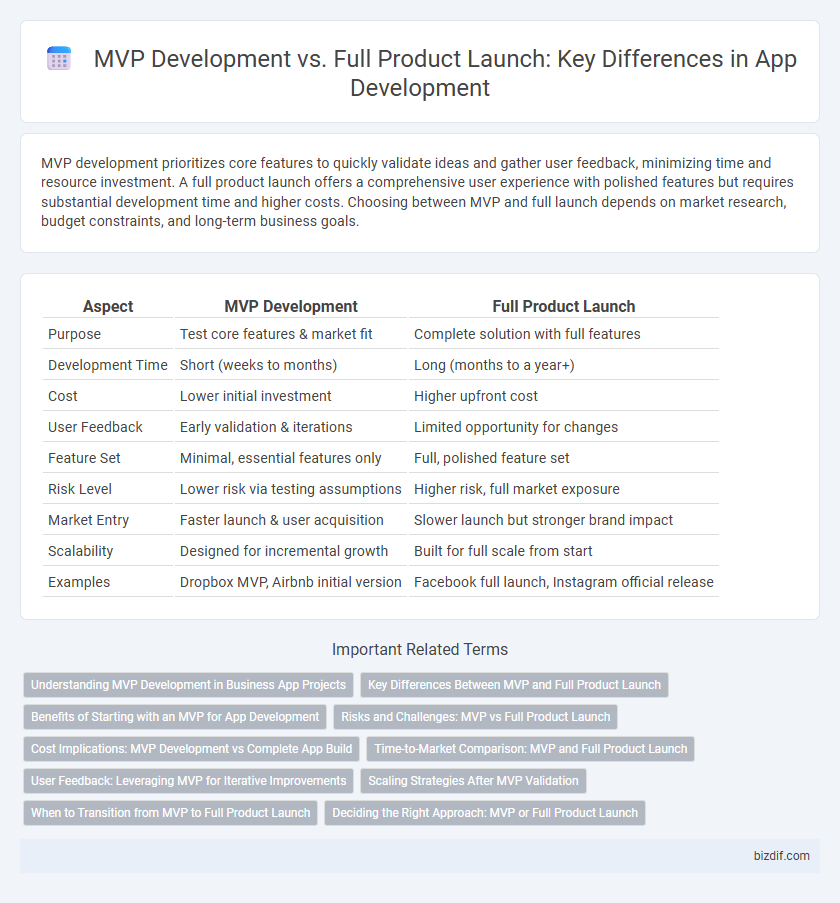MVP development prioritizes core features to quickly validate ideas and gather user feedback, minimizing time and resource investment. A full product launch offers a comprehensive user experience with polished features but requires substantial development time and higher costs. Choosing between MVP and full launch depends on market research, budget constraints, and long-term business goals.
Table of Comparison
| Aspect | MVP Development | Full Product Launch |
|---|---|---|
| Purpose | Test core features & market fit | Complete solution with full features |
| Development Time | Short (weeks to months) | Long (months to a year+) |
| Cost | Lower initial investment | Higher upfront cost |
| User Feedback | Early validation & iterations | Limited opportunity for changes |
| Feature Set | Minimal, essential features only | Full, polished feature set |
| Risk Level | Lower risk via testing assumptions | Higher risk, full market exposure |
| Market Entry | Faster launch & user acquisition | Slower launch but stronger brand impact |
| Scalability | Designed for incremental growth | Built for full scale from start |
| Examples | Dropbox MVP, Airbnb initial version | Facebook full launch, Instagram official release |
Understanding MVP Development in Business App Projects
MVP development in business app projects focuses on creating a simplified version of the product with core features to quickly validate market demand and gather user feedback. This approach reduces time-to-market and development costs while allowing iterative improvements based on real user data. Emphasizing essential functionality helps businesses minimize risks and optimize resource allocation before investing in a full product launch.
Key Differences Between MVP and Full Product Launch
MVP development focuses on building a minimal set of core features to validate hypotheses and gather user feedback quickly, minimizing initial investment and time-to-market. In contrast, a full product launch includes a complete feature set, polished design, and scalability considerations, aiming to deliver a comprehensive user experience and support broader market adoption. MVP prioritizes iterative improvement through real user data, while full product launch emphasizes product stability, brand positioning, and long-term growth.
Benefits of Starting with an MVP for App Development
Starting with an MVP in app development accelerates time-to-market, enabling early user feedback that guides iterative improvements and reduces costly post-launch revisions. MVP development focuses on core functionalities, optimizing resource allocation and minimizing initial investment risks. This approach enhances market validation potential, increasing the chances of product-market fit before committing to a full product launch.
Risks and Challenges: MVP vs Full Product Launch
Building an MVP reduces the risk of market failure by allowing early user feedback and iterative improvements before investing heavily in features. Full product launches carry higher financial and reputational risks due to larger development costs, longer timelines, and less flexibility for pivoting based on user data. MVPs face challenges like potential underwhelming user experience and limited functionality, while full launches risk poor market fit if assumptions remain untested.
Cost Implications: MVP Development vs Complete App Build
MVP development significantly reduces initial costs by focusing on core features that validate market demand, allowing startups to allocate resources efficiently and minimize financial risk. In contrast, a full product launch requires a substantial budget to cover comprehensive design, development, testing, and marketing efforts, increasing the financial burden before user feedback is obtained. Choosing MVP development over a complete app build accelerates time-to-market while optimizing budget allocation and reducing the likelihood of costly post-launch pivots.
Time-to-Market Comparison: MVP and Full Product Launch
MVP development significantly reduces time-to-market by focusing on core features that validate product hypotheses, enabling faster user feedback and iterative improvements. In contrast, a full product launch requires extensive development and testing phases, resulting in longer delays before market entry but offering a comprehensive feature set initially. Prioritizing MVP accelerates entry and adaptability, while full product launches suit well-funded projects aiming for immediate market impact with a complete solution.
User Feedback: Leveraging MVP for Iterative Improvements
MVP development enables rapid user feedback collection, allowing developers to identify essential features and pain points early in the app lifecycle. User insights gathered from MVP testing guide iterative improvements, optimizing the product for market fit before a full product launch. This approach reduces development risks and enhances user satisfaction by aligning the final app with actual user needs and preferences.
Scaling Strategies After MVP Validation
After validating an MVP through user feedback and market testing, scaling strategies involve optimizing performance, expanding feature sets, and increasing infrastructure capacity to support higher user loads. Prioritizing customer-driven enhancements and iterative development ensures that the product evolves based on real user needs, reducing risks before a full product launch. Leveraging cloud services and automated testing accelerates deployment cycles and maintains product stability during rapid scaling phases.
When to Transition from MVP to Full Product Launch
Transitioning from MVP to full product launch occurs when user feedback validates core features and market demand proves sustainable. Key performance indicators such as active user growth, retention rates, and revenue generation signal readiness for scaling. Investing in robust infrastructure and comprehensive feature sets follows to enhance user experience and competitive positioning.
Deciding the Right Approach: MVP or Full Product Launch
Choosing between MVP development and a full product launch hinges on factors such as market validation, budget constraints, and time-to-market goals. MVP development allows for early user feedback and iterative improvements, reducing risks and development costs. A full product launch suits well-established concepts with sufficient resources and confidence in market demand, aiming for a complete user experience from the start.
MVP Development vs Full Product Launch Infographic

 bizdif.com
bizdif.com